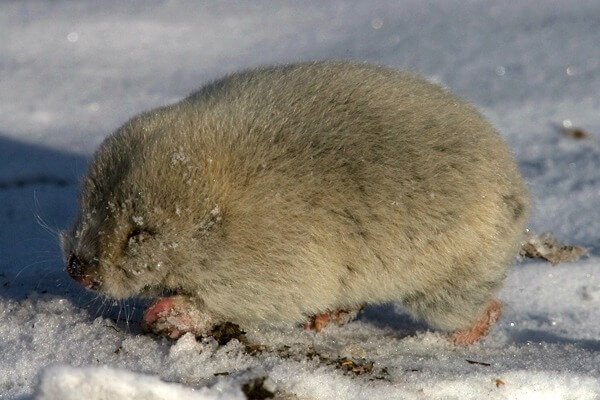
So, what’s happening with the zokor? They’ve been quietly digging their way into a conservation crisis largely due to habitat loss, climate change, and unsustainable agricultural practices. It’s a bit like trying to navigate a maze where the walls keep closing in. In this article, we’ll dive deeper into the world of the zokor, exploring its status in the wild, the threats it faces, and what can be done to help protect this fascinating species. Grab a coffee, and let’s dig in!
What Is the Zokor?
The zokor belongs to the family of rodents known as **Myospalacinae**. These critters are small—typically weighing around 100 to 200 grams—and have adapted remarkably well to their underground lifestyle. Picture a chunky little potato with small eyes and short legs, equipped with strong claws for digging. Zokors primarily inhabit grasslands and mountainous regions, where their elaborate burrow systems provide shelter and a place to store food.
Zokors are also known for their unique diet. They primarily feed on roots, tubers, and other underground plant parts, which they can find and dig up thanks to their impressive sense of smell. Think of them as nature’s gardeners, playing a vital role in their ecosystem by aerating the soil and dispersing seeds. Unfortunately, their precious underground homes are becoming scarcer.
Current Conservation Status
The zokor is classified as **vulnerable** by the International Union for Conservation of Nature (IUCN). This means they’re at risk of becoming endangered unless conservation measures are taken. One major factor contributing to their vulnerable status is habitat loss. As cities expand and agricultural practices intensify, these little burrowers are losing the homes they rely on.
You might be wondering how serious this issue really is. Well, the zokor’s slow reproduction rate doesn’t help either. They usually have just one litter a year, which makes population recovery difficult. Plus, if their habitat continues to shrink, those populations could decline even faster.
Threats to the Zokor
The main threats to zokors stem from human activities. **Agricultural expansion** is probably the biggest culprit. As farmers clear land for crops, they disrupt the zokor’s burrowing habitat, leaving them without adequate shelter or food sources. It’s kind of like moving the furniture in a room and expecting someone to feel at home.
Another challenge is **climate change**. As the earth warms, the environments that zokors depend on are shifting as well. Changing weather patterns can disrupt their food supply and habitat structure, pushing them further towards the brink of extinction. It’s like if your favorite pizza place suddenly stopped making your go-to meal—you’d feel a bit lost, right?
Lastly, **predation** and competition from other rodents are factors too. As their populations decline, zokors face increased pressure from other animals that compete for the same resources.
Conservation Efforts Underway
The good news is that steps are being taken to protect zokors and their habitats. Several organizations and conservationists are working hard to raise awareness and push for policies that safeguard these little rodents. For instance, habitat restoration projects aim to create safer spaces for zokors to thrive.
Moreover, researchers are beginning to study zokor populations more closely. By understanding their behaviors and needs, conservationists can develop more effective strategies to protect them. It’s a bit like putting together a puzzle—essential pieces need to be gathered to see the bigger picture.
Policies that regulate agricultural practices also play a critical role. When farmers use sustainable methods, it not only supports their livelihoods but also protects the natural habitats that zokors—and many other species—rely on.
How You Can Help
Now that you know about the zokor’s struggles, you might be wondering how you can make a difference. Here are some simple but impactful steps you can take:
- Stay Informed: Knowledge is power! Keep yourself updated on conservation efforts and the status of the zokor.
- Support Sustainable Practices: Whether you’re buying organic food or supporting eco-friendly brands, every little bit helps the environment.
- Volunteer: Many wildlife organizations welcome volunteers. Whether it’s a local group or a larger international organization, your time can make a big difference.
- Donate: If you’re in a position to do so, consider donating to conservation organizations that focus on protecting wildlife like the zokor.
By taking these actions, you’re not only helping the zokor but contributing to a healthier planet overall.
Future Outlook for the Zokor
So, what does the future hold for the zokor? It really depends on the collective effort to address the threats they face. If habitat preservation and sustainable agricultural practices become a priority, there’s hope for the zokor population to stabilize and even thrive.
The more people learn about the zokor, the more support there will be for conservation efforts. It’s a bit like building a community—when people come together for a common cause, positive change can happen.
In summary, while the zokor is facing significant challenges, awareness and action can help protect this unique species. They might not be the most famous animal on the endangered list, but every creature plays a part in the tapestry of life.
With ongoing efforts and a little bit of support from folks like us, the zokor might just find a way to dig its way back into safety and prosperity. So, the next time you hear about an endangered species, remember that even the most unsuspecting animals need a helping hand. And who knows? Those tiny burrowing rodents might just surprise us with their resilience if given the chance.
